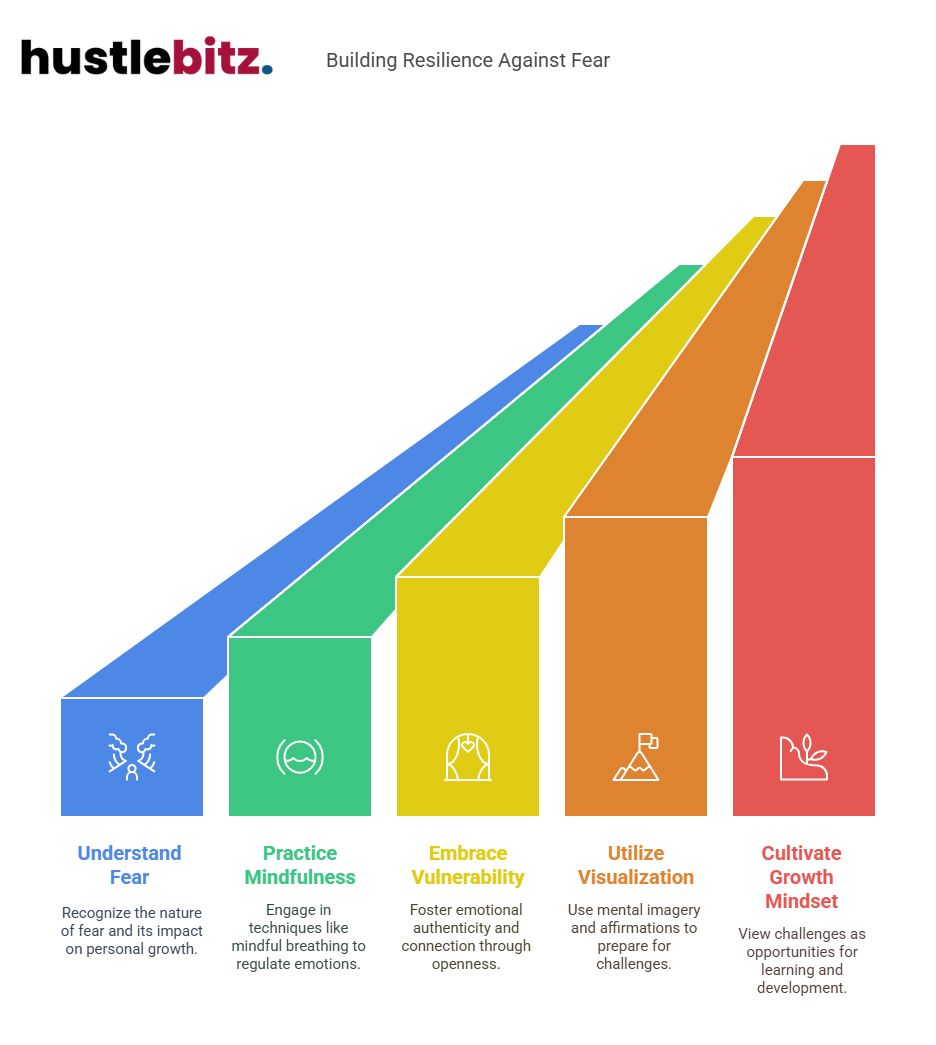Fearlessly advancing requires innovative strategies to confront and manage fear with confidence. Understanding the nature of fear is essential; it can trigger physiological responses that vary among individuals. Techniques such as mindfulness, positive affirmations, and visualization can effectively reframe fear, promoting resilience and emotional regulation. Embracing vulnerability and adopting a growth mindset further empower individuals to see challenges as opportunities for growth. Incremental challenges coupled with accountability foster gradual exposure to fears, enhancing confidence. This holistic approach not only transforms fear into motivation but also nurtures lasting emotional balance, illustrating that deeper insights are waiting to be uncovered.
Key Takeaways
- Understand the nature of fear and use cognitive appraisal to transform fear into motivation for personal growth and resilience.
- Practice mindfulness and emotional regulation techniques, such as mindful breathing and gratitude journaling, to enhance your ability to cope with fear.
- Embrace vulnerability to foster emotional authenticity and connection, allowing for personal development and resilience against future challenges.
- Utilize visualization techniques and positive affirmations to mentally prepare for facing fears, enhancing motivation and commitment to overcoming obstacles.
- Cultivate a growth mindset by viewing challenges as opportunities for learning, helping to reframe setbacks and build resilience over time.

Understanding the Nature of Fear
Understanding the nature of fear requires a nuanced exploration of its psychological underpinnings and the impact it has on human behavior. Fear, fundamentally an evolutionary mechanism, serves as a critical survival tool by activating specific fear triggers that elicit rapid responses.
These triggers can be external, such as threatening situations, or internal, including memories or anticipatory thoughts. The resulting fear responses—ranging from fight-or-flight reactions to paralysis—are deeply embedded within our neurobiology, shaping how individuals navigate their environments.
Fear perception varies significantly among individuals, influenced by personal experiences, cultural contexts, and innate temperament. This variability underscores the complexity of fear as a subjective experience; what instills dread in one person may provoke excitement in another.
Recognizing the role of cognitive appraisal in fear perception is crucial. It is within this appraisal that individuals can cultivate fear resilience—the ability to withstand and adapt to fear-inducing stimuli.
Moreover, fear transformation is a powerful concept that allows individuals to reconceptualize their fears, shifting from avoidance to confrontation. By channeling fear into a motivational force, one can foster growth and personal development.
This process encourages individuals to engage with their fears rather than retreat, ultimately leading to greater confidence and mastery over one’s emotional landscape. Thus, understanding fear not only illuminates its psychological dimensions but also empowers individuals to harness its potential for positive change.
The Power of Vulnerability

Embracing vulnerability often serves as a catalyst for personal growth, enabling individuals to confront their fears and build stronger connections with themselves and others. This journey is rooted in emotional authenticity, which allows individuals to express their true selves without the fear of judgment. By recognizing the strength in vulnerability, one can transform moments of discomfort into opportunities for profound personal development.
The process of embracing vulnerability can be distilled into three key elements:
- Connection through Sharing: Engaging in open dialogues about fears and insecurities fosters a sense of community and belonging. Sharing experiences can alleviate the isolation often associated with shame, creating a foundation of trust and understanding.
- Overcoming Shame: Acknowledging one’s vulnerabilities is integral to dismantling the barriers that shame erects. By confronting these emotions head-on, individuals can reclaim their narratives, thus empowering themselves to navigate their fears with confidence.
- Fostering Resilience: The act of being vulnerable teaches individuals to adapt and persevere in the face of adversity. This resilience not only enhances self-awareness but also equips individuals with the tools necessary to tackle future challenges.
Visualization Techniques for Success

Visualization techniques serve as powerful tools for enhancing performance and achieving success by enabling individuals to mentally rehearse their goals and desired outcomes. These methods harness the power of mental imagery to create vivid representations of success, fostering a profound sense of confidence and preparedness.
Guided visualization is one effective approach, wherein an individual follows a structured narrative that leads them through specific scenarios related to their goals. This technique not only cultivates clarity regarding desired outcomes but also helps in reducing anxiety by familiarizing the mind with potential challenges and triumphs. By engaging with this method, individuals can visualize their future self, embodying the traits and behaviors necessary for success.
Creative visualization further expands upon these principles by encouraging individuals to imagine their success in a more abstract and imaginative manner. This can involve incorporating emotions, colors, and sensations that evoke a strong sense of achievement, thus reinforcing motivation and commitment to their goals.
Additionally, scenario planning is a valuable tool within the visualization repertoire. By envisioning multiple potential futures, individuals can strategize effectively, preparing for various outcomes while maintaining focus on their primary objectives. This adaptability is crucial in navigating the complexities of personal and professional endeavors.
Incorporating these visualization techniques into daily practice can dramatically enhance one’s ability to confront fears and pursue excellence, ultimately leading to a more confident, successful, and fulfilling life.
Embracing a Growth Mindset
Cultivating a growth mindset is essential for individuals seeking to transform challenges into opportunities for personal and professional development. This mindset encourages the belief that abilities can be developed through dedication and hard work, fundamentally enhancing one’s approach to overcoming obstacles and embracing change. By fostering resilience, individuals can better navigate the uncertainties of life, turning potential setbacks into learning experiences.
To effectively embrace a growth mindset, consider the following strategies:
- Cultivating Curiosity: Engage in lifelong learning by seeking new experiences and knowledge. This not only broadens perspectives but also encourages the exploration of innovative solutions to problems.
- Reframing Challenges: View difficulties as opportunities for growth rather than insurmountable barriers. This shift in perception enables individuals to approach challenges with a proactive attitude, ultimately fostering resilience and adaptability.
- Emphasizing Effort Over Results: Focus on the process of learning and the effort put forth, rather than solely on outcomes. This approach reinforces the understanding that persistence and hard work are critical components of success.
Setting Incremental Challenges

Setting incremental challenges can significantly enhance an individual’s ability to confront and overcome fears, fostering a gradual build-up of confidence and resilience. By adopting a methodical approach to fear management, individuals can utilize incremental exposure to desensitize themselves to their anxieties, thereby facilitating goal progression.
The strategy of setting smaller, manageable challenges allows for realistic and achievable objectives. This approach not only minimizes the risk of overwhelming oneself but also creates a structured pathway to success. Engaging in self-reflection exercises after each challenge can further solidify insights gained and provide a clearer understanding of personal growth.
Incorporating accountability partners into this journey can amplify commitment and motivation. These individuals can provide encouragement and constructive feedback, ensuring that one remains on track while navigating through their fears. To maintain momentum, it is essential to celebrate milestones, recognizing each achievement as a stepping stone toward broader objectives.
Here’s a table summarizing key strategies for setting incremental challenges:
| Strategy | Description |
| Incremental Exposure | Gradually facing fears in small, controlled steps |
| Goal Progression | Establishing clear, achievable targets |
| Self Reflection Exercises | Analyzing experiences to foster growth |
| Accountability Partners | Collaborating with others for support |
| Celebrating Milestones | Acknowledging achievements to boost motivation |
The Role of Positive Affirmations

Positive affirmations serve as powerful tools in the journey of overcoming fear, as they reinforce self-belief and foster a resilient mindset. Engaging in affirmation practices can significantly alter one’s internal dialogue, transforming limiting beliefs into empowering narratives. This shift is crucial for confidence building, particularly when facing daunting challenges.
Implementing effective self-talk strategies is essential. Daily affirmations can enhance positive reinforcement, creating a foundation for courage and resilience.
To maximize the impact of affirmation practices, consider the following:
- Personalization: Tailor your affirmations to resonate deeply with your specific fears and aspirations. Phrasing such as ‘I am capable of facing my fears’ can instill a sense of empowerment.
- Consistency: Integrate daily affirmations into your routine. Repetition solidifies positive messages in your subconscious, thereby facilitating a robust mindset that is less susceptible to fear.
- Visualization: Pair your daily affirmations with visualization techniques. Envisioning success while reciting affirmations amplifies their effect, embedding a confident self-image into your psyche.
Mindfulness and Fear Management

Mindfulness practices provide individuals with essential tools to manage fear by fostering a heightened awareness of the present moment and reducing anxiety-driven thoughts.
By engaging in mindful breathing, practitioners can anchor themselves in the here and now, which serves to mitigate the physiological responses associated with fear. This intentional focus on breath not only calms the mind but also enhances emotional regulation, enabling individuals to confront their fears with a grounded perspective.
Fear exposure, a critical component of fear management, can be approached through mindfulness techniques. By gradually exposing oneself to feared stimuli while employing mindfulness, individuals can observe their thoughts and bodily responses without becoming overwhelmed. This process promotes desensitization and empowers individuals to reclaim agency over their emotional experiences.
Incorporating self-compassion practices further enriches the mindfulness toolkit. By cultivating a non-judgmental stance towards one’s fears, individuals can reduce self-criticism and foster resilience in the face of adversity.
Additionally, gratitude journaling serves as a powerful practice that shifts focus from fear to appreciation, reinforcing positive emotional states and enhancing overall well-being.
Ultimately, the synergy of mindful breathing, fear exposure, emotional regulation, self-compassion practices, and gratitude journaling creates a comprehensive framework for individuals seeking to conquer fear with confidence.
Final Thoughts
Conquering fear with confidence requires a combination of innovative strategies and a commitment to personal growth. By embracing mindfulness, positive affirmations, visualization, and incremental challenges, individuals can transform fear into a source of motivation and resilience. Cultivating a growth mindset allows for a more adaptive and proactive approach to challenges, while the power of vulnerability fosters authentic connections and personal development. With these tools, individuals can navigate fear with greater emotional balance and confidence, empowering themselves to move fearlessly forward in both personal and professional endeavors.




